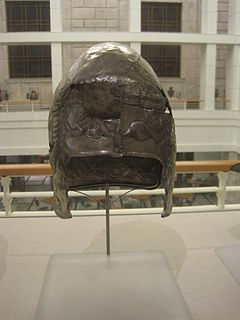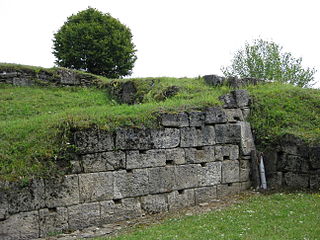 W
WThe history of Dacian warfare spans from c. 10th century BC up to the 2nd century AD in the region defined by Ancient Greek and Latin historians as Dacia, populated by a collection of Thracian, Ionian, and Dorian tribes. It concerns the armed conflicts of the Dacian tribes and their kingdoms in the Balkans. Apart from conflicts between Dacians and neighboring nations and tribes, numerous wars were recorded among Dacians too.
 W
WThe Dacian Draco was the standard ensign of troops of the ancient Dacian people, which can be seen in the hands of the soldiers of Decebalus in several scenes depicted on Trajan's Column in Rome, Italy. It has the form of a dragon with open wolf-like jaws containing several metal tongues. The hollow dragon's head was mounted on a pole with a fabric tube affixed at the rear. In use, the draco was held up into the wind, or above the head of a horseman, where it filled with air and gave the impression it was alive while making a shrill sound as the wind passed through its strips of material.
 W
WThe Decebalus Treasure is written by Cassius Dio concerning events said to have happened in the Roman world during the 2nd century AD.
 W
WThe draconarius was a type of signifer who bore a cavalry standard known as a draco in the Roman army.
 W
WThe Helmet of Agighiol is a Getae silver helmet dating from the 5th century BC, housed in the National Museum of Romanian History, Bucharest.
 W
WThe Helmet of Iron Gates is a Geto-Dacian silver helmet dating from the 4th century BC, housed in the Detroit Institute of Arts, United States.
 W
WThe Helmet of Peretu is a Geto-Dacian silver helmet dating from the 5th century BC, housed in the National Museum of Romanian History, Bucharest. It comes from Peretu area, in the Teleorman County, Romania. There were 50 artifacts having 750g. The helmet is similar to the Helmet of Coţofeneşti and other three Getian gold or silver helmets discovered so far.
 W
WThe Ludus Dacicus or The Dacian Gladiatorial Training School was one of the four gladiator training schools (ludi) in Ancient Rome. It was founded by Domitian, completed by Trajan, and was used to train gladiators drawn from among the Dacian prisoners taken by both emperors in their Dacian Wars. It was located east of the Colosseum, on the slopes of the Caelian Hill.
 W
WMurus Dacicus is a construction method for defensive walls and fortifications developed in ancient Dacia sometime before the Roman conquest. It is a mix between traditional construction methods particular to Dacian builders and methods imported from Greek and Roman architecture and masonry, and – although somewhat similar construction techniques were used before, during and long after the period – it has peculiarities that make it unique.